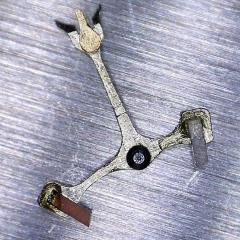Lathe Motor suggestion.
-
Recently Browsing
- No registered users viewing this page.
-
Topics
-
Posts
-
I expect the stem on the Citizen will have snapped but if you're luck they'll be enough protruding from the crown to unscrew it. Do you know what movement's in the Citizen and what all the movements look like for general condition.
-
By Neverenoughwatches · Posted
There are specific dies that will mostly fit this crystal shape, but I just find it easier doing them by hand. Occasionally the odd one can be difficult, there is a workaround, and it isn't by force . Same Andy, generally it's possible to get 2 1/2 sides in before a little pushing is required. Things usually tighten up when the crystal is skewed too much, typically on smaller ones, I tend to try keeping them as flat as possible to the case lip -
By Tigermuffins · Posted
To anyone who might be able to help. I am coming up on almost 20 years since I bought an Emporio Armani Meccanico AR 4205 watch. Sadly the crown and main stem is now missing due to an unforeseen accident. I went to my local store, they sent it in for repairs, but returned it due to being a model that has gone out of date. The watch itself is not very expensive, but it holds a great sentimental value to me. So I figure it would be a nice small project to get it fixed on my own. But since this is my first dive into wristwatch repairs, could anyone point me to somewhere on the web where such parts could be bought? Or if there are parts from a different model that would work on this? Any and all assistance in this matter is greatly appreciated :) -
How does the size of the new compare to the old.
-
By Embezelled · Posted
As I wait for my first set of watchmaker screwdrivers to arrive, which is taking longer than I had hoped, I'll post a photo of the small stockpile I made to work on. I'll be starting with the Citizen: the missing crown is my doing. I unintentionally applied pressure from the side and off it came. I've put it aside, and I'm hoping it's detached rather than snapped, and without damage to other parts, but until I have the screwdrivers I can't remove anything to examine the stem section. Two of the Seikos are are working, quite well actually, although for the price I paid, none of them should really be in "serviced" condition, so after letting them run on one wind, I've left them unwound. The Citizen was the cheapest, and so the one I could most bear to go wrong with, although all of them are rather nice watches. I think they're all from the late 50s to very early 60s, but I haven't managed to date them more closely than that. The Citizen and the Seiko Crown each have a small crack in the crystal, so I'll be hoping to replace those.
-





Recommended Posts
Join the conversation
You can post now and register later. If you have an account, sign in now to post with your account.
Note: Your post will require moderator approval before it will be visible.